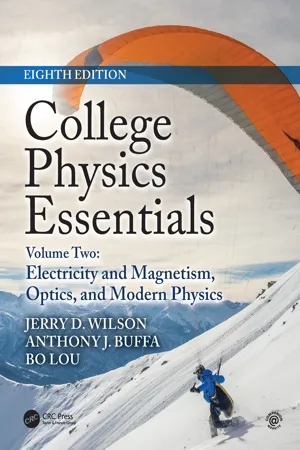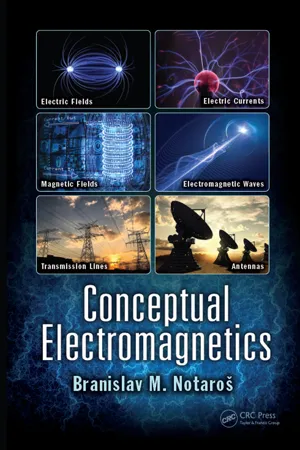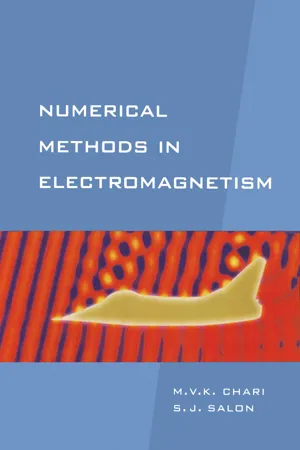Physics
Electric Field Lines
Electric field lines are a visual representation of the electric field around a charged object. They show the direction and strength of the electric field at different points in space. The lines are drawn such that the electric field is tangent to the lines at any point, and the density of lines indicates the strength of the field.
Written by Perlego with AI-assistance
Related key terms
Related key terms
1 of 4
Related key terms
1 of 3
10 Key excerpts on "Electric Field Lines"
- eBook - ePub
- Michael M. Mansfield, Colm O'Sullivan(Authors)
- 2020(Publication Date)
- Wiley(Publisher)
Section 16.1 , the electrostatic force on a charge on the surface of a conductor must be normal to the surface.The field lines around a single fixed point positive charge q are illustrated in Figure 16.6 . Since the repulsion between a test positive charge and the charge q is along the line joining them, the field lines are directed radially outwards as shown (a radial field). When field are parallel over a particular region of space (as illustrated in Figure 16.7 ), the field is said to be uniform in that region. For any field, the field lines may be considered to be essentially parallel if the region of space considered is sufficiently small.Field lines around a point positive charge.Figure 16.6Field lines representing a uniform field.Figure 16.7Electric field strength
While a force field exists everywhere due to the presence of a charge or a configuration of charges, no force is exerted unless another charge is present at some point in the field. It would be useful, however, if a physical quantity could be defined which contains information on the ‘strength’ and the ‘shape’ of a field. To achieve this, the electric field strength at a point r in an electric field is defined aswhere F is the force that would be experienced by a point positive charge q if placed at the point r. Note that since F is a vector then, from its definition and since q is a scalar, E is also a vector quantity in the same direction as F. Thus, the direction of E at any point is tangential to the electric field line through that point. The force on a charge q located at a point in a field at which the electric field strength is E - David V. Guerra(Author)
- 2023(Publication Date)
- CRC Press(Publisher)
Figure 5.14 . Near the charged particle, the lines are close together, consistent with the fact that the electric field due to a charged particle is stronger at points closer to the particle than it is at points farther away. A diagram in which Electric Field Lines are used to convey information about the electric field in a region of space is referred to as an electric field diagram. Here, two-dimensional diagrams giving the electric field in the plane of the diagram are demonstrated; in practice, the electric field extends outward in all directions.FIGURE 5.14 Electric field of a positive charge.For the case of a negatively charged particle, the pattern is similar, but the arrows are all flipped so they point toward the particle, as shown in Figure 5.15 .FIGURE 5.15 Electric field of a negative charge.The Electric Field Lines for an arrangement of a particle having a positive charge and another particle having an equal amount of negative charge are shown in Figure 5.16 .FIGURE 5.16 Electric field of a positive and negative charge in the same area.Just like gravitational field lines, the Electric Field Lines never cross and the relative number of field lines starting or ending at a charge is proportional to the charge. Figure 5.17 shows two positively charged particles, one with a charge of +q and the other with a charge of +2q (where q > 0).FIGURE 5.17 Electric field of two charges with different magnitudes of charge.Note that there are twice as many field lines coming out of the particle having charge +2q as there are coming out of the particle having charge +q.Given that each charged particle in a distribution of charged particles creates an electric field vector at all points in space around the charged particle, a distribution of charged particles also causes an electric field to exist in the region around that distribution. At any given point in space, the total electric field is the vector sum of all the individual contributions to the electric field, at that point in space, by all the charged particles making up the distribution. So, for example, the electric field between two lines of charges should look something like the E-field in Figure 5.18- eBook - ePub
- Sivaji Chakravorti(Author)
- 2017(Publication Date)
- CRC Press(Publisher)
electric fieldlines .Behaviour of an electric field is conventionally analyzed considering the test charge to be a unit positive charge. Hence, the test charge will experience repulsive force from a positive source charge and attractive force from a negative source charge. Therefore, the test charge will move away from the positive source charge and move towards the negative source charge. Accordingly, the directions of electric fieldlines are such that they originate from a positive charge and terminate on a negative charge, as shown in Figure 1.1 . Figure 1.1 a shows the electric fieldlines originating from a positive source charge whose magnitude is integer (N ) multiple of +e , whereas Figure 1.1 b shows the electric fieldlines terminating on a negative source charge of the same magnitude. The electric fieldlines are the directions of the force experienced by a unit positive charge +e , as shown in Figure 1.1 .FIGURE 1.1 Electric fieldlines due to (a) positive source charge and (b) negative source charge.FIGURE 1.2 Electric fieldlines due to a pair of positive and negative charges.Figure 1.2 depicts the electric fieldlines due to a pair of positive and negative charges, showing the fieldlines to be originating from the positive charge and terminating on the negative charge.According to SI unit system, one C of source charge gives rise to one C of electric fieldlines.1.4 Coulomb’s Law
It is the law that describes the electrostatic interaction between electrically charged particles. It was published by the French physicist Charles Augustin de Coulomb in 1785. He determined the magnitude of the electric force between two point charges using a torsion balance to study the attraction and repulsion forces of charged particles. The interaction between charged particles is a non-contact force that acts over some distance of separation. There are always two charges and a separation distance between them as the three critical variables that influence the strength of the electrostatic interaction. The unit of the electrostatic force, like all forces, is Newton. Being a force, the strength of the electrostatic interaction is a vector quantity that has both magnitude and direction. - eBook - ePub
College Physics Essentials, Eighth Edition
Electricity and Magnetism, Optics, Modern Physics (Volume Two)
- Jerry D. Wilson, Anthony J. Buffa, Bo Lou(Authors)
- 2019(Publication Date)
- CRC Press(Publisher)
between two closely spaced parallel plates is uniform and points from positive to negative plate. Its magnitude is given byE =4 π k QA( electric field between parallelplates, not near edges )(15.5) • Electric Field Lines provide a visualization of the electric field. The line spacing at any location is inversely related to the field strength, and tangents to the lines give the field direction. Field lines start at positive charges and end at negative charges.• Under electrostatic conditions,End of Chapter Questions and Exercises Multiple Choice Questions 15.1Electric ChargeE →fields associated with charged conductors have the following properties: In the conductor’s interior, the field is zero. Excess charge on such a conductor resides entirely on its surface. The electric field near its surface is perpendicular to that surface. Excess charge is most dense at locations of highest surface curvature and thus the surface electric field is greatest there also.1.A combination of two electrons and three protons would have a net charge of (a) + 1, (b) − 1, (c)2.An electron is just above a fixed proton. The direction of the force on the proton is (a) up, (b) down, (c) zero. 3.In Question 2, which one feels the greater magnitude force: (a) the electron, (b) the proton, or (c) both feel the same? 15.2Electrostatic Charging+ 1 .6 ×, (d)10C− 19− 1 .6 ×.10C− 194.A rubber rod is rubbed with fur. The fur is then quickly brought near the bulb of an uncharged electroscope. The sign of the charge on the leaves of the electroscope is (a) positive, (b) negative, (c) zero.5.A stream of water is deflected toward a nearby electrically charged object that is brought close to it. The sign of the charge on the object (a) is positive, (b) is negative, (c) is zero, (d) can’t be determined by the data given.6.A balloon is charged and then clings to a wall. The sign of the charge on the balloon (a) is positive, (b) is negative, (c) is zero, (d) can’t be determined by the data given. - eBook - ePub
Human Exposure to Electromagnetic Fields
From Extremely Low Frequency (ELF) to Radiofrequency
- Patrick Staebler(Author)
- 2017(Publication Date)
- Wiley-ISTE(Publisher)
In practice, an electric field is created by an inequality of charges between two distinct points. This inequality may be due to a difference in potential or voltage.The most natural representation of an electric field consists of applying a voltage between two parallel planar electrodes, forming a planar capacitor (Figure 1.1 ). This set-up makes calculating the field strength simple.At the center of this set-up, it can be demonstrated that the electric field is proportional to the voltage and inversely proportional to the distance:Uniform electric field between two parallel planar electrodesFigure 1.1.[1.3]where VABrepresents the difference in potential or voltage (in volts) between the two electrodes and d is the distance between them (in meters). This example introduces the electric field strength unit (V/m or V·m–1 ). A voltage of 1 volt between planes 1 m apart creates an electric field of 1 V·m–1 .The lines on Figure 1.1 represent the spatial distribution and orientation of the electric field. These are the force lines (force F on charge q illustrates [1.2] ). They originate with the positive charge and end with the negative charge or ad infinitum in the absence of opposite sign charges. Field lines cannot intersect. There can be no electric field without electric charges.When the voltage is constant or varies slowly, the field created is called electrostatic. It is limited to the space between the two electrodes.The field is uniform when its strength and direction are constant, as shown in Figure 1.1 . However, if its strength and direction depend on the position, the field is no longer homogeneous, as shown in Figure 1.2 .Non-uniform electric field between two electric conductors of opposite polarityFigure 1.2.The electric particles subjected to a field are attracted by the electrode of opposite polarity and repelled by the electrode of the same polarity. They move if they are free, e.g. in a conductor or in the vacuum. When their movement is limited to a volume, e.g. in an insulated conductor, they gather on its surface (Figure 1.3 - eBook - ePub
- Jo Verhaevert(Author)
- 2024(Publication Date)
- Routledge(Publisher)
Both of these fields are simply a means of transmitting the forces involved, from one body to another. However, the fields themselves cannot be detected by the human senses, since you cannot see, touch, hear or smell them. This tends to make it more difficult to understand their nature. An electric field behaves in the same way as these other two examples, except that it is the method by which forces are transmitted between charged bodies. In all three cases we can represent the appropriate field by means of arrowed lines. These lines are usually referred to as the lines of force.To illustrate these points, consider Figure 3.2 which shows two oppositely charged spheres with a small positively charged particle placed on the surface of Q1 . Since like charges repel and unlike charges attract each other, the small charged particle will experience a force of repulsion from Q1 and one of attraction from Q2 .Figure 3.2 Two oppositely charged spheresThe force of repulsion from Q1 will be very much stronger than the force of attraction from Q2 because of the relative distance involved. The other feature of the forces is that they will act so as to be at right angles to the charged surfaces. Hence, there will be a resultant force acting on the particle. Assuming that it is free to move, it will start to move in the direction of this resultant force. For the sake of clarity, the distance moved in this direction is greatly exaggerated in the diagram. However, when the particle moves to the new position, force F1 will have decreased and F2 will have increased. In addition, the direction of action of each force will have changed. Thus the direction of action of the resultant will have changed, but its magnitude will have remained constant. The particle will now respond to the new resultant force F. This is a continuous process and the particle will trace out a curved path until it reaches the surface of Q2 . If this ‘experiment’ was carried out for a number of starting points at the surface of Q1 , the paths taken by the particle would be as shown in Figure 3.3 - eBook - ePub
Introduction to Electromagnetism
From Coulomb to Maxwell
- Martin J N Sibley(Author)
- 2021(Publication Date)
- CRC Press(Publisher)
E , defined asWe can now write Coulomb’s law asE =(2.6)D εor, more generally,F =q 2EF = q E(2.7)From this equation, we can see that the force is directly dependent on the electric field strength, also known as the electric field intensity. We should note that, as E is directly proportional to D , it is also a vector quantity.The field strength is an important parameter in that it introduces us to the idea of a force field. Figure 2.5a shows an isolated point charge at the centre of a Gaussian sphere. As this figure shows, electric flux, ψ , radiates outwards from the charge. Also shown are the electric flux density and electric field strength vectors.FIGURE 2.5 Flux, flux density and electric field strength in (a) a positive charge field and (b) a negative charge field.Let us now introduce a positive test charge of 1 C. This charge will experience a repulsive force acting in a radial direction – the direction of the E field. As this test charge is 1 C, the magnitude of the force will also be the magnitude of the E field. Thus, the lines of flux are also the lines of force emanating from the charge. A similar situation arises with a negative charge: Figure 2.5b . So, we can say that a force field surrounds each charge, and that the field is repulsive if the charges are alike, and attractive if the charges are dissimilar.Example 2.3Determine the flux density and electric field strength at a distance of 0.5 m from an isolated point charge of +10 μC. If an identical charge is placed at this point, determine the force it experiences. Assume that the charge is in air.Solution Let us place the point charge at the centre of a Gaussian sphere of radius 0.5 m. Now, from Gauss’ law the total flux through the sphere is equal to the enclosed charge, i.e., - eBook - ePub
- Branislav M. Notaroš(Author)
- 2017(Publication Date)
- CRC Press(Publisher)
Its fundamental property is that there is a force (Coulomb force) acting on any stationary charge placed in the space. To quantitatively describe this field, we introduce a vector quantity called the electric field intensity vector, E. By definition, it is equal to the electric force F e on a small probe (test) point charge Q p placed in the electric field, divided by Q p, that is, E = F e Q p (Q p → 0) (definition of the electric field intensity vector; unit: V/m). (1.3) The unit for the electric field intensity is volt per meter (V/m). From the definition in Eq. (1.3) and Coulomb’s law, Eq. (1.1), we obtain the expression for the electric field intensity vector of a point charge Q at a distance R from the charge (Figure 1.4) E = 1 4 π ε 0 Q R 2 R ^ (electric field due to a point charge), (1.4) where R ^ is the unit vector along R directed from the center of the charge (source point) toward the point at which the field is (to be) determined (field or observation point). Figure 1.4 Electric field intensity vector due to a point charge in free space. In the general case, charge can be distributed throughout a volume, on a surface, or along a line. Each of these three characteristic continuous charge distributions is described by a suitable charge density function. The volume charge density (in a volume v) is defined as [ Figure 1.5(a) ] ρ = d Q d v (volume charge density ; unit : C / m 3), (1.5) the surface charge density (on a surface S) is given by [ Figure 1.5(b) ] ρ s = d Q d S (surface charge density ; unit: C/m 2), (1.6) and the line charge density (along a line l) is [ Figure 1.5(c) ] Q ′ = d Q d l (line charge density; unit: C/m). (1.7) Note that the symbol ρ v is sometimes used instead of ρ,. σ instead of ρ s, and ρ 1 instead of Q ′ - eBook - ePub
- Sheppard Salon, M. V.K. Chari(Authors)
- 1999(Publication Date)
- Academic Press(Publisher)
1BASIC PRINCIPLES OF ELECTROMAGNETIC FIELDS
1.1 INTRODUCTION
This chapter is intended to introduce and to discuss the basic principles and concepts of electromagnetic fields, which will be dealt with in detail in succeeding chapters. The concept of flux and potential is discussed and Maxwell’s set of equations is presented. The description of electric and magnetic materials then follows. We then discuss the set of differential equations that are commonly used as a starting point for the numerical methods we will study. An explanation of some of the more popular choices of state variables (scalar and vector potential or direct field variables) is then presented.1.2 STATIC ELECTRIC FIELDS
The electric charge is the source of all electromagnetic phenomena. Electrostatics is the study of electric fields due to charges at rest. In SI units the electric charge has the units of coulombs after Charles Augustin de Coulomb (1736–1806). The charge of one electron is 1.602 × 10−19 coulombs. In rationalized MKS units an electric charge of Q coulombs produces an electric flux of Q Coulombs. In Figure 1.1 we see the electric charge emitting flux uniformly in the radial direction in a spherical coordinate system with origin at the charge. If we consider a closed surface around the charge (for example, the sphere shown in Figure 1.1 ), then all of the flux must pass through the surface. This would be true for any number of charges in the volume enclosed by the surface. Using the principle of superposition, we conclude that the total flux passing through any closed surface is equal to the total charge enclosed by that surface . This is Gauss’ law and one of Maxwell’s equations. If we define the electric flux density as the local value of the flux per unit area then we may writeFigure 1.1 Point Charge and Flux(1.1)where ρ is the charge density. This is the integral form of Gauss’ law. From the symmetry of Figure 1.1 - eBook - ePub
Molecular Driving Forces
Statistical Thermodynamics in Biology, Chemistry, Physics, and Nanoscience
- Ken Dill, Sarina Bromberg(Authors)
- 2010(Publication Date)
- Garland Science(Publisher)
E.The Equipotential Surfaces Around Two Positive Point ChargesFigure 21.3 Lines of equal electrostatic potential around two positive point charges.The dashed lines in Figure 21.3 show the electric field E in the (x,y) plane due to two charges of the same sign: q at x = -ℓ/2, and q at x = +ℓ/2. The x axis is an axis of symmetry of this electric field and charge constellation. The solid curves indicate the intersection of the plane of the page and the equipotential surfaces. If you rotate the solid curves about the x axis, out of the plane of the page, you generate the full three-dimensional equipotential surfaces. The equipotential surfaces become more nearly perfect spheres as their distance from the charges increases. Therefore, at a distance far away from the point charges, you can view the electrostatic potential as though it were due to a single point charge equal to 2q at x = 0.Figure 21.4 The same amount of work is required to move a charge from point A to D to C as from point A to B to C, because work is done only in the radial steps.Electrostatic Interactions Are Conservative ForcesThe reversible electrostatic work is a path-independent quantity that sums to zero around a cycle. Figure 21.4 shows two different pathways for moving a charge q2 from point A to point C in the field of a single point charge q1 . Path 1 is from A to B to C. Path 2 is from A to D to C. Moving a particle along circumference segments AB and DC involves no work because there is no change in radius. Both radial segments, AD and BC, involve the same change in radius, so the reversible work in moving a charge along either pathway ABC or ADC is the same:Figure 21.5 Even with an array as complex as the charges in the protein superoxide dismutase (gray), no work is done in moving a charge in a cycle. One such cycle is shown by the heavy line. Dotted lines are equipotential contours. Source: I Klapper, R Hagstrom, R Fine, et al., Proteins: Structure, Function and Genetics 1
Index pages curate the most relevant extracts from our library of academic textbooks. They’ve been created using an in-house natural language model (NLM), each adding context and meaning to key research topics.
Explore more topic indexes
Explore more topic indexes
1 of 6
Explore more topic indexes
1 of 4









